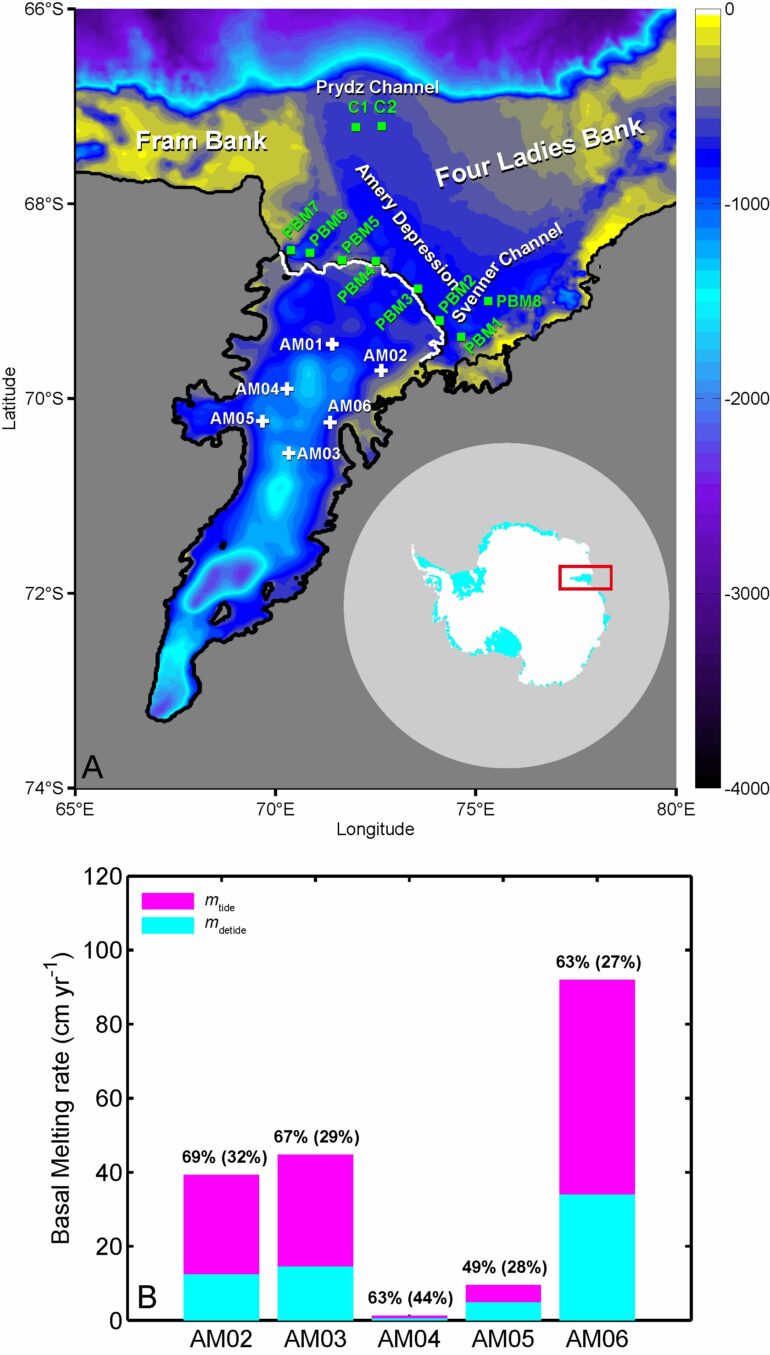The ice shelves—the marine-terminating glaciers of the Antarctic Ice Sheet—are melting, and it’s not just because of rising atmospheric temperatures. In a one-two punch, ice shelves in Antarctica are fighting a losing battle against rising temperatures both at the surface and under their body.
Called basal melting, oceanic heat and compression contribute to the phenomenon, but tides may play a bigger role than previously thought, according to a multi-institution research collaboration based in China. Based on observational data in Prydz Bay, which are the first made of tidal currents and their role in basal melting, the researchers found that tidal currents from the third largest bay in Antarctica may be responsible for up to 69% of basal melting on the Amery Ice Shelf.
The team published their findings on August 15 in Ocean-Land-Atmosphere Research.
“Tides play a key role in regulating the circulation and water properties around Antarctica, yet tidal currents and the corresponding influences in Prydz Bay have not been quantified with observational data sets,” said corresponding author Zhaomin Wang, professor in the Southern Marine Science and Engineering Guangdong Laboratory (Zhuhai) in China.
“The Amery Ice Shelf Oceanographic Research experiment and the Chinese Antarctic Expedition provide long-term hydrography observations of 10 moorings over the continental shelf and six borehole sites drilled through the Amery Ice Shelf.”
The moorings are anchored to the sea floor of Prydz Bay. Measurements from the moorings and the boreholes allowed researchers to observe the characteristics of tidal currents in the bay. They used these observations to inform two numerical modeling analyses to quantify the tidal contributions to the shelf’s basal melting.
However, Wang noted, the observations did not include significant long-term information about velocity, so they employed simulated velocity in the sub-ice-shelf cavity from the models, which may have skewed the tidal currents’ true contribution to basal melting.
Despite Prydz Bay being the third largest bay around the Antarctic, the rise and fall of its tides—the tidal currents—are much weaker than those of the two larger bays, with an average magnitude of only three centimeters per second.
“Such weak tidal currents are not expected to play an important role in regulating the circulation and hydrographic properties in Prydz Bay,” Chengyan Liu, the first author said. “However, the observed maximum tidal velocity of about 11 centimeters per second occurs at the Amery Ice Shelf’s front, and the maximal time-average tidal kinetic energy—the intensity with which tides rise and fall—reaches about 31% of the total kinetic energy over the outer continental shelf.”
And, at the borehole sites, Liu added, a tide-like temperature pulsing was identified in the ocean layer adjacent to the Amery Ice Shelf’s basal surface. Taken together, these variables allowed the researchers to estimate the maximal tidal contribution to the shelf’s basal melting at 69%.
“Since there are no long-term velocity observations in the sub-ice-shelf cavity, the tide-induced melting in this study may be overestimated due to the uncertainties in the modeling results,” Liu said. “Our understanding of the AIS basal mass balance could benefit from more long-term observations and advanced numerical models. However, this study still provides the benchmark validation for sensitivity experiments and open boundary constraints in future modeling studies focused on Prydz Bay.”
According to Wang, the researchers will continue to collect more long-term observations in the bay to inform their understanding of how much tidal currents contribute to basal melting for the Amery Ice Shelf.
More information:
Chengyan Liu et al, Observed Tidal Currents in Prydz Bay and Their Contribution to the Amery Ice Shelf Basal Melting, Ocean-Land-Atmosphere Research (2023). DOI: 10.34133/olar.0020
Provided by
Ocean-Land-Atmosphere Research (OLAR)
Citation:
Tides may be responsible for up to 69% of under-ice melting in an Antarctica ice shelf (2023, August 25)



